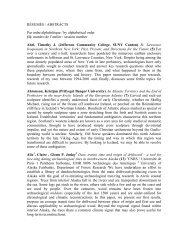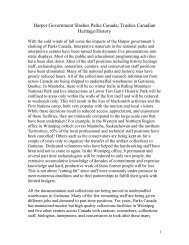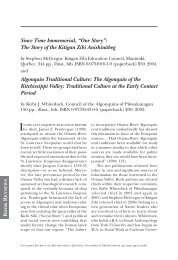Prehistoric Native Americans and Ecological Change - Canadian ...
Prehistoric Native Americans and Ecological Change - Canadian ...
Prehistoric Native Americans and Ecological Change - Canadian ...
Create successful ePaper yourself
Turn your PDF publications into a flip-book with our unique Google optimized e-Paper software.
310 • Fritzduring the series of catastrophic 500-yearfloods that occurred from 650 to 400 BP.Thus climatic, geologic, ecological, <strong>and</strong>anthropogenic interactions were all factorsthat forced the ab<strong>and</strong>onment ofCahokia” (pp. 128–129). Although theDelcourts present a reasonable pictureof social complexity <strong>and</strong> demography,the degree to which they stress environmentaldamage seems extreme, sincemost archaeologists look to a combinationof social <strong>and</strong> ecological causes.Milner (2004: 167–168), for example,invokes “enfeebled leadership,” statingthat: “Even in the best of circumstances,chiefs inevitably experienced reversals ofone kind or another that they were powerlessto stop. Their positions were surelytested during times of repeated shortages,especially if coupled with losses atthe h<strong>and</strong>s of their enemies.” A demographicvacuum persisted across theAmerican Bottom long after Cahokia’spopulation had declined, allowing timefor trees to grow back <strong>and</strong> soil fertilityto be replenished. Geographic shifts ofchiefdoms in eastern North Americaclearly had both social <strong>and</strong> environmentalexplanations.Chapter 8 moves out in scale toregional-level interactions but back intime to the late Pleistocene, taking onthe controversial issue of megafaunalextinctions. The authors implicatehumans, not as participants in a blitzkriegon unwary megafauna, but ashunters who displaced former keystonepredators at a time of severe stress due torapidly changing climate <strong>and</strong> vegetation.An unexpected twist is the Delcourts’positive view of the proposal by DennisStanford <strong>and</strong> Bruce Bradley that theroots of Clovis technology came acrossthe North Atlantic with descendants ofSolutreans. I am concerned that nonarchaeologistswho read this book willbe unaware of the skepticism with whichthis scenario is viewed in the professionalliterature. Nevertheless, it is noteworthythat scientists of the Delcourts’ calibreseem to favour European ancestryfor early occupants of eastern NorthAmerica.The final chapter, “The ecologicallegacy of prehistoric <strong>Native</strong> <strong>Americans</strong>,”discusses the strengths <strong>and</strong> limitations oftraditional ecological knowledge <strong>and</strong> theimplications that paleoecological studieshave for current forest managementpolicy. It ends with five conclusions:1. That humans “have been part of theNorth American ecological setting”since their arrival;2. That human ecosystems are panarchical<strong>and</strong> adaptive, with limits to sustainableresource use;3. That <strong>Native</strong> North <strong>Americans</strong> madeenvironmental impacts that hadconsequences throughout late Pleistocene<strong>and</strong> Holocene times;4. That there is “no such thing as aHolocene, ‘presettlement,’ naturalenvironment untouched by humanh<strong>and</strong>s in North America;” <strong>and</strong>5. That in addition to historical documents<strong>and</strong> traditional knowledge,integrated paleoecological <strong>and</strong>archaeological data “make it possibleto reconstruct the direct influences ofprehistoric humans on their ecologicalsetting.”A wealth of information is packedinto this small book, <strong>and</strong> it should beessential reading even for scholarsskeptical of the panarchical perspective,those who may think the impactof early <strong>and</strong> mid-Holocene burningis overlooked, or those who believethe Delcourts exaggerate the negativeeffects of late pre-Columbian agriculturalsocieties. The writing is clear <strong>and</strong>engaging, <strong>and</strong> the figures summarize<strong>Canadian</strong> Journal of Archaeology 30 (2006)








